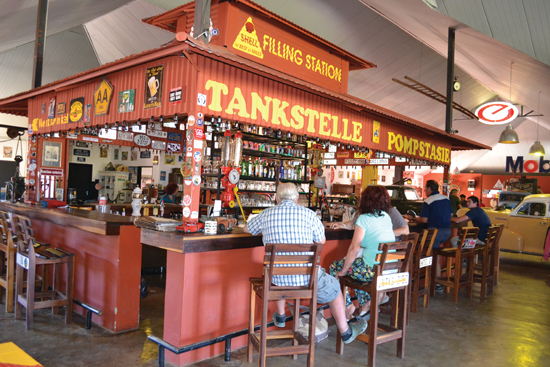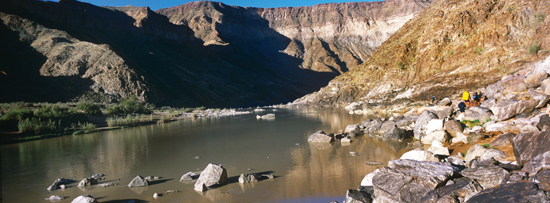
Testimonial | Otjimbondona – Something Special & New
June 5, 2015Photographic Feature by Anja Denker
June 8, 2015Text Ron Swilling | Main photograph Paul van Schalkwyk
Many folk travel to the ends of the Earth, yet haven’t visited the spectacular canyon right on their doorstep. Besides being a scenic voyage and an awe-inspiring adventure, the journey is unexpectedly spiced with charm.
As I turned onto the gravel roads towards the spot where the Earth opens up into an enormous smile, grinning for all to see, I wondered about the route to the canyon. Was it purely a landscape jaunt, I mused, while following a road that skirted a table-top mountain and led into an earthy tapestry dotted with spiky Euphorbias. I mean, so far from civilization, what else could there be?
Answers soon began to flood in as if I’d directed my question to the canyon PRO herself. And it wasn’t long after passing the green oasis of palms and vineyards around Naute Dam that I came across signs for biltong, cold drinks and arts & crafts, crowned with colorful flags swaying languidly in the warm breeze. They directed me past an old railway siding, farmhouse and wind-turbine to the padstal entrance adjacent to a large truck emblazoned with the sign ‘Tea and Coffee and Kudu Pies’.
Mount Canyon Farmyard, a fresh addition to the route, is run by newly-married husband and wife team, Simoné and Jannaman Jochimsen. The couple met at a sokkie dance in Windhoek two years ago. Afterwards, the smitten Jannaman drove 1500 km to the Cape to take Simoné out for dinner. She refused, but couldn’t resist the lure of love for long. The couple married and moved to Jannaman’s family farm where they opened the small farm stall that sells Simoné’s karringmelk beskuit and kookmelk koekies, Jannaman’s hand-crafted windmills, paintings by Ma and jams made by Tannie Ansie. O ja, and home-baked kudu pies. Anticipating the great Earth Wonder ahead of me, I asked for their thoughts about the Fish River Canyon. “It’s a different kind of beauty. You can’t really explain it,” Simoné chirped. Jannaman agreed, “It’s one of the great wonders of the world, you have to experience it yourself.” It reminded him of what the pastor had said in church when describing the ocean: “When you stand at a distance, you can’t really relate to it, but it’s when you are in the waves that you only begin to understand its power.”
Waving them goodbye, I continued on the well-maintained gravel road. Only one vehicle appeared, announcing its presence in a cloud of dust long before it approached me. The sun was slowly sinking in the sky, colouring everything in that late afternoon light that makes you feel like you have driven through the gates of heaven. The flat-topped Klein Karas Mountain kept me company for a while until I turned towards the Spiegelberg spire and the distinctive flat-topped Holoog Mountain. I stopped every few minutes, finding something else to photograph, while my car’s fan spun wildly, trying to keep up with the Namibian heat and my bizarre behaviour. A gemsbok stood frozen, framed against a backdrop of purple mountain, a kudu bull loped across the road with the sun anointing its twirled horns, ostriches and springbok darted away, and signs warned drivers to be cautious in the fence-free wildlife area. I later discovered that I had entered the Gondwana Canyon Park, 130 000 hectares of land that had been a disparate group of sheep farms before they were gradually purchased, the fences dismantled, animals reintroduced and the land ‘re-wilded’. It was a serendipitous bonus to the canyon trip.
Now, someone had a sense of humour! As I neared the Roadhouse, signs painted with a sad or puzzled face enquired ‘Hungry?’ ‘Thirsty?’ ‘Sleepy?’ The last one beamed a smile. How could I resist? Turning off ‘the main drag’ towards the red-roofed Roadhouse, I was met with old Chevys, a Dodge, a windmill, quiver trees bursting from old car bonnets, bird chatter and enough charm to keep the planet lubricated and smiling for about a century – or more. In addition to the attraction of the Roadhouse’s famous Amarula cheesecake, burgers and cappuccinos, it has over the years become an iconic stop and travelling tradition en route to the canyon, 30 km away. An International truck serves as the reception desk, a pompstasie is the bar and guests dine amongst the intriguing old motoring paraphernalia, American automobiles from yesteryear and car cabs that serve as fireplaces in the wintertime. The entertainment continues when curious bathroom visitors open a Pandora’s Box naughtily positioned on the paintings of a buxom blonde and dashing stud, sending an alarm ringing through the restaurant and alerting friends to the fact that he or she peeked and therefore owes them a drink. It was all in good fun and laughter rang through the multi-coloured interior like refreshing water in a mountain spring.
Okay, I was more than convinced about the charm. “But, what about the canyon?” I asked Roadhouse manager Johan van Schalkwyk, as we sipped coffee at a table flanked by a canary-blue Chevrolet truck and wacky bric-a-brac. “If you know anything about geological history, it’s like a look back in time,” he replied thoughtfully, adding that the canyon is not about people, it’s about standing on the edge by yourself. “It makes you feel small – humble!”
And then, it was time to finally visit the grand earth masterpiece for myself. I paid my entrance fee at Hobas and drove along the 10 km road that didn’t give any hint that the landscape was anything out-of-the-ordinary. So, where, then, was this great canyon? I climbed out, hot and frazzled, at the viewpoint parking to be bowled over by grandeur. The sight before me had me spellbound and frozen, in awe – or gratitude. I was just a simple human being who had arrogantly confronted eternity. In a millisecond of recognition, I acknowledged my short life span as a blink in the Earth time that had taken millions-of-years for this chasm-of-chasms to form, shaped by earth cataclysms and the Fish River’s timeless journey.

The Fish River Canyon is 550 meters deep, covers a distance of 90km and is up to 27km at its widest. Photo ©Ron Swilling
A car pulled up and broke my reverie. I strolled along the path to the hikers’ viewpoint and then, with my head spinning, continued southwards. My first stop was Canyon Lodge, its reception area housed in a century-old German farmhouse. An old bedstead remains on the roof, placed there by the original owner, in accordance with an old German tradition to inform visitors that a marriageable bachelor was resident on the premises. Okay, I got the charm bit, I really did.
/Ai-/Ais was calling, and the hot-springs – definitely more of an attraction in the cooler months of the year, I decided, as I cursed my car’s long defunct air conditioner. I made my way past an old Chev on the roadside whose fan whizzed and whistled in the wind, stifling heat and canyon silence, past the views of the mountainous plateaus that dropped into canyon depths, into the /Ai-/Ais Richtersveld Transfrontier Park and along the corrugated road into the forbidding mountains around the resort. ‘All shook up’, I stumbled out, to leap into the warm spring waters that have made this a popular holiday destination from the time when people arrived by ox-wagon, spending months soaking in the therapeutic pools surrounded by Phragmites reeds. Today, it attracts holiday-seekers in 4x4s and people like me, who like to pitch their tents under the stars and dream of eternity.
Before reaching the tar, Noordoewer and the mighty Orange River that bisects the two countries, I pored over my well-thumbed map noting my options: travel the well-graded gravel road or the stonier and more remote route to the moon-like landscape and river? I chose the latter. Why? Because Life is just ‘a flash of a firefly’, a short Earth adventure – a reality that became clear to me while standing on the edge of the second largest canyon in the world.
A GIGANTIC GRIN
Considered to be the second largest canyon in the world after the Grand Canyon in Arizona, USA, the Fish River Canyon is 550 metres deep and covers a distance of 90 kilometres to its end at /Ai-/Ais. Its widest point measures 27 kilometres.
This great artist is in no rush. The sculpturing of the canyon is a piece of art that has taken hundreds of millions of years to reach this point, and continues. The slow geological formation of the canyon walls began long before the tectonic event when the earth’s crust subsided along faults, giving the Fish River an easier route to follow. It was the river’s passage that began the slow erosion of the canyon. Glaciers are also believed to have scraped along the ancient riverbed, helping to shape the canyon depths.
When the supercontinent Gondwana began to break up 120 million years ago, it lifted the continental edges to form the younger and deeper part of the canyon. The increased gradient caused the Fish River to flow faster, carving out the canyon millimetre by millimetre, year by year. In the last few million years, it managed to cut through the hard quartzites of the Nama group and reach the ancient gneisses of the Namaqualand Metamorphic Complex. These layers are visible today on the canyon walls, marked by a line of unconformity separating the two, which gives us a glimpse way back in time. TNN
WHAT DO DO IN AROUND THE CANYON
- Fish River Canyon 90 km trail: A 5-day wilderness trail for the fit and self-sufficient (May to mid-Sept). Contact NWR: www.nwr.com.na
- Slackpacking in the northern part of the canyon for friends and family (guided and catered trail; accommodation is in cabins and tented camps, positioned along riverbanks and up on plateaus; mules carry gear). Contact Gondwana: +264 (0)61 230066, www.gondwana-collection.com
- Exploring the canyon viewpoints: Several viewpoints to the north and south of the main viewpoint provide different perspectives from which to gasp at the canyon grandeur.
4×4 Wildebeest and Mountain Zebra drives (permits available at the Roadhouse and Canyon Lodge)
- Walks and guided drives with the lodges in the area, such as the fully catered 3-5 day canyon hike offered by Fish River Lodge, www.fishriverlodge.com.na
- Wallowing in the hot spring at /Ai-/Ais – at the large outdoor pool or indoors at the spa.
- Purchase some homemade padkos at Mount Canyon Farmyard (south of Naute Dam)
- Enjoy lunch and inspiration at the Roadhouse
WHERE TO DREAM
- /Ai-/Ais Hot Springs Resort chalets and camping www.nwr.com.na, +264 (0)61 285 7200
- Hobas Campsite – camping (keep eyes open for baboon visitors) www.nwr.com.na, +264 (0)61 285 7200
- The Roadhouse – in the Roadhouse rooms surrounding inner courtyards or at the campsite +264 (0)61 230066, www.gondwana-collection.com
- Canyon Lodge – chalets nestled amongst giant granite boulders www.gondwana-collection.com, +264 (0)61 230066
- Canyon Village, positioned in an amphitheater of rock, suitable for larger groups
- The secluded Mountain Camp for self-caterers +264 (0)61 230066, www.gondwana-collection.com
HOW TO GET THERE
There is a choice of routes to reach the canyon’s eastern side and the main canyon viewpoint. If travelling from the south, the C10 and the more remote C37 (reached from Aussenkehr) lead to the most southerly point of the canyon at /Ai-/Ais.
The C12, near Grünau, is the route to take to reach the canyon viewpoint, Hobas and the Roadhouse. Canyon Lodge, Canyon Village and Mountain Camp are approx. 30 km southwards.
If travelling from the north, the C12 can be taken from Seeheim or the D545 via the Naute Dam oasis. Mooi ry.
This article was first published in the Winter 2015 issue of Travel News Namibia.










